I have working code to find the x,y at a given angle on an ellipse :
getPointOnEllipse(origin_x, origin_y, radius_x, radius_y, angle) {
var r_end_angle = end_angle / 360 * 2 * Math.PI;
var x = origin_x + Math.cos(r_end_angle) * radius_x;
var y = origin_y + Math.sin(r_end_angle) * radius_y;
return {x: x, y: y}
My question is how do I do this calculation if the ellipse is rotated at angle r, as if created by:
ellipse(origin_x, origin_y, radius_x, radius_y, r);
Update: I tried the suggestion below, and it didn't quite work. Here's the original (0) rotation:
And here's after approximately 90-degree rotation:
Here's the code I tried:
/*
* origin_x - Center of the Ellipse X
* origin_y - Center of the Ellipse Y
* radius_x - Radius X
* radius_y - Radius Y
* angle - angle along the ellipse on which to place the handle
* rotation - Angle which the ellipse is rotated
*/
getPointOnEllipse(origin_x, origin_y, radius_x, radius_y, angle, rotation) {
var r_end_angle = (angle + rotation) / 360 * 2 * Math.PI;
var endX = origin_x + Math.cos(r_end_angle) * radius_x;
var endY = origin_y + Math.sin(r_end_angle) * radius_y;
var cosA = Math.cos(rotation);
var sinA = Math.sin(rotation);
var dx = endX - origin_x;
var dy = endY - origin_y;
rotated_x = origin_x + dx * cosA - dy * sinA;
rotated_y = origin_y + dx * sinA + dy * cosA;
Here's some logging:
X 369, Y 233, radiusX 104, radiusY 17, end_angle 0, rotation 0, endX 473, endY 233, cosA 1, sinA 0, dx 104, dy 0, rotated_x 473, rotated_y 233
X 369, Y 233, radiusX 104, radiusY 17, end_angle 90, rotation 0, endX 369, endY 250, cosA 1, sinA 0, dx 0, dy 17, rotated_x 369, rotated_y 250
X 369, Y 233, radiusX 104, radiusY 17, end_angle 180, rotation 0, endX 265, endY 233, cosA 1, sinA 0, dx -104, dy 0, rotated_x 265, rotated_y 233
X 369, Y 233, radiusX 104, radiusY 17, end_angle 270, rotation 0, endX 369, endY 216, cosA 1, sinA 0, dx 0, dy -17, rotated_x 369, rotated_y 216
Here after a 90-degree rotation the points don't seem to end up on the ellipse:
X 369, Y 233, radiusX 104, radiusY 17, end_angle 0, rotation 96.40608527543233, endX 357.396254311691, endY 249.89385326910204, cosA -0.5542897094655916, sinA 0.8323238059676955, dx -11.603745688309004, dy 16.89385326910204, rotated_x 361.3706805758866, rotated_y 213.97783720494053
X 369, Y 233, radiusX 104, radiusY 17, end_angle 90, rotation 96.40608527543233, endX 265.6493682360816, endY 231.10323387787258, cosA -0.5542897094655916, sinA 0.8323238059676955, dx -103.35063176391839, dy -1.896766122127417, rotated_x 427.86491525130737, rotated_y 148.03016676384783
X 369, Y 233, radiusX 104, radiusY 17, end_angle 180, rotation 96.40608527543233, endX 380.603745688309, endY 216.10614673089796, cosA -0.5542897094655916, sinA 0.8323238059676955, dx 11.603745688309004, dy -16.89385326910204, rotated_x 376.6293194241134, rotated_y 252.02216279505947
X 369, Y 233, radiusX 104, radiusY 17, end_angle 270, rotation 96.40608527543233, endX 472.35063176391833, endY 234.89676612212745, cosA -0.5542897094655916, sinA 0.8323238059676955, dx 103.35063176391833, dy 1.8967661221274454, rotated_x 310.1350847486927, rotated_y 317.969833236
I'm sure I got something wrong here - any ideas?

